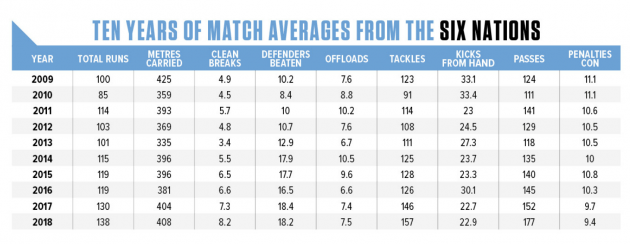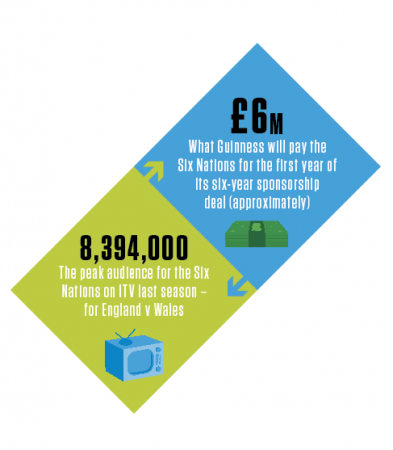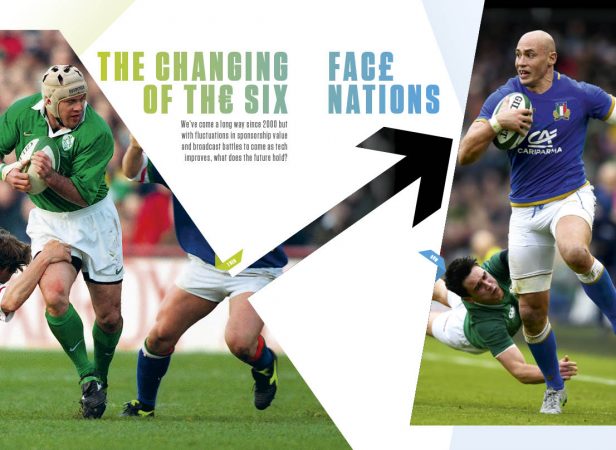We’ve come a long way since 2000 but with fluctuations in sponsorship value and broadcast battles to come as tech improves, what does the future hold?
Special Report: The Changing Face of the Six Nations
Twenty years ago, before the first-ever Six Nations in 2000, we had qualms. Could this new competition ever be as good as the five-team tournament it was replacing?
Then, in their competitive debut, Italy shocked Scotland. The Scots would also stun Grand Slam-chasing England. Brian O’Driscoll announced himself on the big stage with a hat-trick against France. Shane Williams broke opposition hearts for the first time. Martin Johnson ended up not featuring at all for England.
The shirts were baggy, the hair was bad and Grandstand was still on the telly. But like the winds, things would change. Many want even more changes.
We may look back at 2000 and sigh at how simple a lot of it still was. Italy’s players reputedly got no fee for playing then; Scotland’s starters, we’re told by a source, got around £2,500 to play and half as much again if they won. As we jump into the 2019 Six Nations, England’s stars can get up to £25k a game and can invoice for a further £9k on image rights each season.
As shirts got tighter and training ground tech evolved in the last two decades, so has the rugby. Scrums and defences have changed beyond recognition. Styles in attack have mutated over generations. For example, France went from kings of joue to sultans of stodge. Every team has changed philosophy at least once.

Look at the average match statistics from the table above. You can track changes in attack over the last decade. It suggest that adventure slid towards 2013, which is considered a nadir for attacks. But the numbers climb again in terms of runs, breaks and passes after 2013. The figures suggest that fans are now getting more marauding rugby.
However, there are those that suggest 2013 was a bad year for the Six Nations in a more commercially significant way.
Rugby World understands that in the wake of the 2013 Lions tour, banking powerhouse HSBC presented the Six Nations – who are intrinsically tied to the Lions – a proposal to sponsor the touring side for 12 years and the Six Nations for eight. The money, it is believed, was slightly less than Royal Bank of Scotland were paying to attach their name to the tournament at the time. But according to some in the sponsorship world, the bank’s extra budget for advertising or marketing increased the deal’s significance, particularly with its long-term nature.
So confident were HSBC that the deal was wrapped up that they flew in their CEO for a big meeting – a rarity. When the Six Nations rejected that proposal, there was “shock and awe” in the room, according to one insider.

In the years since, the sponsorship market has changed greatly. In 2017, after RBS ended their 14-year dalliance with the Six Nations, a lofty price tag was put on the competition. Potential sponsors balked, and the 2018 edition of the tournament was reportedly sponsored by RBS-owned NatWest for a knock-down price of £11m.
This season sees the start of a six-year deal with Guinness, with just £6m being spent on the first year (though that cost is set to steadily rise each year throughout the agreement).
Before this deal, it was reported that HSBC were again interested in sponsoring the event. This has been denied, with a spokesperson telling us: “I can confirm there was no conversation with the Six Nations whatsoever. Over recent years we have turned to sevens and that is our vehicle, our focus, and the game fits with the values of HSBC perfectly.”
According to Simon Chadwick, professor of Sports Enterprise at Salford University, traditional rugby ventures are at a “crossroads” with the sponsorship landscape shifting under rugby’s feet.
“I think the market has changed,” he says. “The Six Nations is out of kilter with the needs and wants of millennials and Generation X consumers. Rugby is not alone as football and Formula One are just two other sports struggling to get to grips with this change. However, there is something about the nature and format of rugby union, about the sport’s socio-cultural underpinnings, and about its image and reputation that is a bit of a turn-off for younger consumers.
“We live in turbulent times. The last thing rugby should do is to assume this is a blip and things will return to normal.”
Of course, the Six Nations provides sublime entertainment. Unions have done well out of it all too. And according to one Six Nations insider, there is a sense of excitement rippling through the board as a new CEO, Ben Morel – who has extensive experience working with the NBA – takes over. Top of his agenda is innovation and reaching new markets.
Some things won’t change, though, as our insider says: “There is absolutely no sign of changing promotion-relegation in the future. Why would teams put around £16-£17m (of profit) each at risk?” Morel confirms with us that the issue is not currently on Six Nations’ agenda.
Morel tells Rugby World: “Our greatest opportunity is to expand our audience.
“We’re already building on strong foundations but at a global level there’s a significant amount of untapped opportunity to be talking to the world about its best rugby championship.

Closed off: No chance of promotion-relegation, as it stands (Getty Images)
“Expanding the global coverage and audience is going to be paramount for me. Domestically, I want to expand the audience as well, with a clear focus on the younger generation. So through digital and social engagements, gaming and other things we can do with that.
“The sponsorship world is evolving. The time when you sell purely inventory boards is gone. You need to adapt and innovate. That’s where digital and social (media) creates humongous opportunity and coverage on a global level, instantly. So sponsored content is one of the untapped opportunities for the Six Nations, given its popularity around the world but also in home markets.”
While these words will relieve some who watched the slide in sponsorship value, there will be other battles. In a few years we will wonder what to do about TV rights.
The current deal with BBC and ITV ends in 2021. Last year ITV’s audience peaked at 8.39m during England v Wales (sic: some 8.9m watched Wales v England in BBC One this season). Alone, BBC Wales pulled in 828,000 for Wales v Scotland and near 800,000 for Scotland v France last term.
No one has teamed up with China’s state-run channels to air the Six Nations yet – something the NBA did in the Nineties – while sources close to South Africa’s SuperSport say their Six Nations ratings have been “underwhelming” of late.
Subscription streaming platform DAZN hold the rights to broadcast in Canada, Germany, Switzerland and Austria until 2021. DAZN would not comment when asked about future rights tenders.

Mobile experience: Streaming, social media and new technologies are high on the 6N agenda (Getty Images)
“We are a free-to-air proposition and that defines the values of the Six Nations,” says Morel of future deals.
“Actually, instead of free-to-air I prefer ‘free-to-view’. More and more of our fans, especially the younger generation, stream the games already on our existing broadcaster platforms.
“The capability of driving high-quality content through digital and social platforms to engage the younger generation will be paramount, as well as some of the new initiatives like virtual reality and eSports. I’d love the Six Nations to have a leading voice there.”
There are new markets out there and fresh ways to reach them. However lucrative that will be, wherever they take the ‘product’, it will certainly be a long way from the baggy shirts of 2000.
Follow our Six Nations homepage which we update regularly with news and features.
Also make sure you know about the Fixtures, Injuries, Table, Venues, TV Coverage by clicking on the highlighted links.






